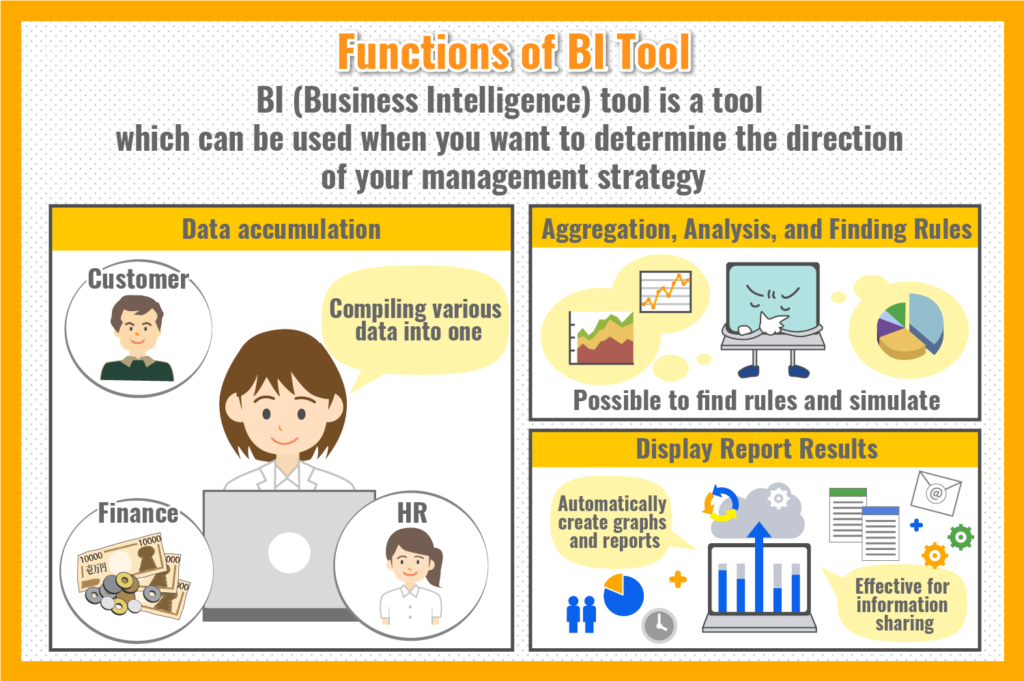What is a BI Tool? Introducing its Functions and How it is Utilized in the Medical Industry
In recent years, technological innovation has been advancing in various business scenes, and ICT has been progressing rapidly in the medical field as well.
Under these circumstances, BI tools that can process big data with high accuracy are attracting attention.
BI tools, which integrate a wide range of information within a corporation and realize data analysis from multiple perspectives, are considered highly necessary in hospital operations.
Thus, in this column, we would like to explain in detail what effects are actually generated by BI tools.
What is a BI Tool?

BI (Business Intelligence) tools are used to accumulate all kinds of data within each corporation and analyze and report on them for use in various business situations.
For example, if you want to determine the direction of your management strategy, you need to make decisions that include a wide range of factors such as accounting, sales performance, and human resources information.
However, if each data is managed by different tools and systems, the first step is to extract the necessary information for each field and analyze them one by one.
In addition, the larger the volume, the more time it takes, and if it is done manually, mistakes and omissions are more likely to occur.
This is where the BI tools introduced here are effective.
The following are detailed explanations of the specific functions of BI tools.
1. Data Accumulation
As mentioned earlier, in order to utilize the information in the corporation, it is first necessary to collect the various data that have been accumulated so far.
In many cases, the tools are scattered throughout the corporation since each department or division could be using a different tool.
Under these circumstances, BI tools have a great advantage in that they can easily integrate various types of data.
For example, if you are using different software for customer management, financials, human resources information, etc., the BI tool will allow you to combine those data into one.
2. Aggregation, Analysis, and Finding Rules
Another function of BI tools is to aggregate and analyze large amounts of data integrated by the accumulation function from all perspectives.
With BI tools, complex information can be extracted and statistically analyzed as needed, and even rules can be discovered and simulated without the need for human intervention.
3. Display Report Results
By using BI tools, you can automate the process of collecting and analyzing huge amounts of information, and even reflecting the results into graphs and reports.
It is also effective for sharing information within the company as it can be visualized on a dashboard.
In addition, the analysis results can be grasped in real time, leading to speedier action.
How BI Tools Work
Let’s look at how the functions that are mentioned above actually work, and how they process information in detail.
1. Collect and Process Data
Utilizing BI tools starts with collecting the data that have been dispersed.
First, information managed in separate systems is integrated into the BI tool through DB connection or API integration.
It is also possible to accumulate by uploading various files, such as CSV files exported from each system.
The information gathered is then converted into data that can be processed within the BI tool and stored, and the time series and items are reorganized.
2. Show Results that Support Decision Making
The data accumulated and processed on the BI tool will be automatically analyzed in the following three methods.
- OLAP (Online Analytical Processing)
This method is to determine the specific reference value needed from the complex information gathered, and then analyzes each transition from multiple perspectives.
This method is used to analyze a single result in depth from all perspectives. - Data mining
This is an analysis method that uses statistics to uncover the rules in data, and a process to find relationships and hidden trends that cannot be found by simply aggregating the data is conducted.
One of features of BI tools is that they can perform analyses that are normally difficult, such as correlation analysis and multiple regression analysis. - Planning
There is also a function to recommend a specific execution plan by making predictions through simulation using the data accumulated in the BI tool.
The process automatically reproduces what results are generated by moving which values and how.
3. Put the Analysis Results in an Easy-to-Understand Format
The results derived from the above process are visualized in graphs and tables that can be understood at a glance.
Of course, in the dashboard view, only the elements needed by each user can be extracted.
Furthermore, it can also be used to automatically create reports by outputting them to PDF or Word files.
Advantages and Disadvantages of BI Tools
As explained so far, BI tools have various functionalities that facilitate business operations, but of course there are disadvantages as well.
Now, let’s take a closer look at what effects you should be aware of.
Advantage: Accurate Information can be Obtained Immediately
The biggest advantage of BI tools is that they can automatically analyze complicated and huge amounts of data and derive the necessary results immediately.
In addition to eliminating the time previously spent on information aggregation and analysis, it also enables a timely understanding of the current situation.
Another advantage is that basically anyone can obtain highly accurate analysis results.
This leads to encourage each person to act promptly.
Disadvantage: A Burdensome Implementation
Although not limited to BI tools, it is inevitable that preparation and setting from installation to the start of operation will be burdensome.
In addition, BI tools need to be linked with data from various mission-critical systems, and in some cases, advanced skills are required to connect each of them
Of course, there are support services provided by the BI tool provider, but the disadvantage is that the cost of these services can be high.
Differences from Excel
Managing and aggregating numerical data is something that can be done in Excel as well.
However, the functionality of BI tools differs greatly from that of Excel, so let’s look at some of the specific differences.
The first difference is how to collect the data in the corporation.
When each department or business uses a different system, data must be extracted and reflected one by one in Excel.
On the other hand, if you link the databases of each system with a BI tool, you can retrieve the necessary information from the integrated state.
Furthermore, when data is updated in each system, it is updated in the BI tool as well.
The second difference is BI tools can automatically handle complex analysis that is difficult to do with Excel.
In addition, while knowledge of functions is required to manage data in Excel, BI tools have relatively low difficulty in operation, making them easy to use not only for managers but also at the field level.
BI tools can be used more widely than Excel.
However, of course, there are some processes that Excel is better suited for.
For example, if you are personally managing figures in a specific field.
There is no need to collect a huge amount of information in a corporation if it is managed in Excel only.
In cases where the amount of information to be handled is limited or small, Excel may be easier to use.
Utilization of BI Tools in the Medical Field
As we have introduced so far, BI tools with advanced functionality in the utilization of big data are playing a remarkable role in the field of medicine.
Let’s take a closer look at some of the possible implementation cases.
Suggesting the Necessary Action for Each Patient in Real Time
BI tools enable the utilization of big data in hospitals’ core systems such as electronic medical records, leading to more precise and timely information for accurate decision making.
For example, we can visualize the occupancy rate of the hospital and share the information daily within the hospital.
By displaying the numerical data of hospital beds on a dashboard in a tool that each doctor and staff uses on a daily basis, it is possible to always grasp the current situation and take appropriate measures.
Facilitate the Optimization of Business Conditions
The financial situation in hospital management will be greatly affected by medical fees.
Therefore, promoting the use of BI tools that are linked to the core system in the hospital will help optimize management.
For example, let’s say that the collection and aggregation of data related to the level of need for nursing care is systematized, and the numerical values are managed on a daily basis.
And if BI tools can automatically analyze and simulate the level of need for nursing care, it will be possible to revise medical fees based on more accurate decisions.
As described above, BI tools can be used very effectively in hospital operations.
Especially in the medical field, where tens of millions of information are accumulated, the need for BI tools that can speed up processing is quite high.
Use of BI Tools in the Pharmaceutical Field
Similar to the medical field, BI tools are also being used in the pharmaceutical field.
The following are some implementation cases of BI tools in the pharmaceutical field.
Utilizing BI Tools to Respond to the Rapidly Changing Trends in the Pharmaceutical Industry
In the pharmaceutical industry, new drugs are developed on a daily basis, and it is necessary to keep abreast of competing products and constantly review business strategies to adapt to the situation.
BI tools enable speedy data analysis and utilization in response to market changes.
Introduction of BI Tools Vitalizes Data Utilization throughout the Company
A pharmaceutical company was using multiple BI tools and Excel to analyze data, but because information was not being shared well between different departments, many departments were doing secondary processing of the data separately.
The company was facing the challenge of not being able to respond to changes in the market since they were not able to effectively utilize its own data and analysis was time-consuming.
With the introduction of BI tools, data is now visualized and making it easier to grasp the information.
The time spent on secondary processing of data, which used to be carried out by each department, has been greatly reduced after the introduction of BI tools.
Let’s Consider Implementing a BI Tool
We, Medical Data Vision, provides data network services and data utilization services to medical institutions and pharmaceutical companies.
These are web-based analysis tools that allow customers to easily analyze the number of patients, the number of days of prescriptions, and the dosage of prescriptions by themselves based on Japan’s one of the largest medical databases.
It is also possible to conduct multifaceted analysis not only diseases and drugs but starting from actual medical practices such as surgeries and tests.
We can propose a variety of systems for reporting and visualizing business conditions, including information utilization platform services that support hospital management.
If you have any questions about data utilization in the medical field, please feel free to contact Medical Data Vision.
For More Information, Please Contact Us Here
About Japanese Healthcare System

What you need to know about the healthcare system in Japan before using the data.
SERVICE

In addition to various web tools that allow you to easily conduct surveys via a browser using our medical database, we offer data provision services categorized into four types to meet your needs and challenges: "Analysis reports" "Datasets," "All Therapeutic Areas Data Provision Service," and "Specific Therapeutic Areas Data Provision Service.

© Medical Data Vision Co., Ltd. All Rights Reserved.





